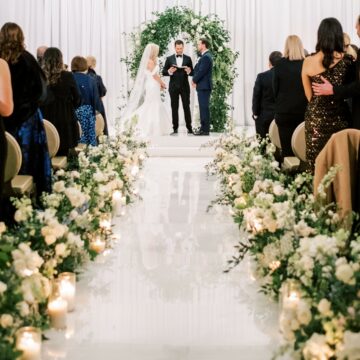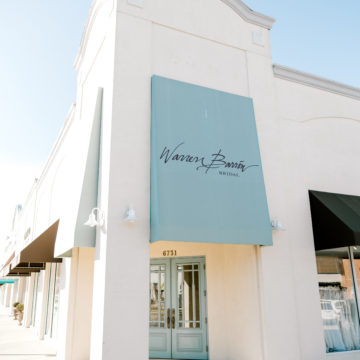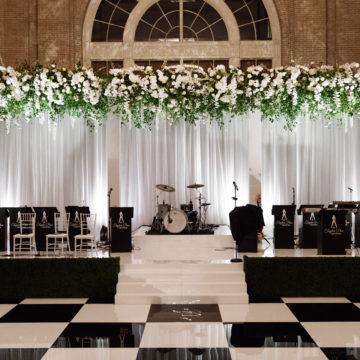
Whether it’s a kids-free ceremony or a unique family situation, it can be unclear how to word certain phrases on your wedding invitation suite. To avoid stepping on any toes, we asked two stationery experts how to navigate these challenging linguistic dos and don’ts.
How to politely say you don’t want kids at your wedding:
“Unfortunately, it’s still rude to ‘uninvite’ or exclude any one person or group of people on the invitation or within that invitation suite itself. The invitation’s only function is to invite.
Take the high road and be pleasantly direct in person with anyone you feel might miss the cues on the envelope. Use your wedding party to spread the word that there are no accommodations for children or simply that no children are being invited. Second, use the envelopes the way they were intended. If you have a mailing envelope only, all members of the household that are invited are named on the envelope. If you have an inner envelope, the additional household members are named as invitees (or unnamed, therefore not invited) on that inner envelope.
An alternative, although many traditional etiquette experts will snub this, is to place the information on your wedding website. This requires a details card in your suite. I advise clients to say something in general like, ‘For additional details about our wedding day, please visit (wedding website).’ Attire, directions, hotel accommodations—and a well worded phrase about children—can be more appropriately housed here. I find a little humor makes the pill easier to swallow for most.” —Heather Wiese-Alexander, owner of Bell’Invito and trained etiquette expert
“We always recommend properly addressing your envelopes so your guests know who exactly is invited. You can also add a short and simple note on your response card. Writing ‘We have reserved ___ seats for you’ on the RSVP card is the perfect way to politely convey who is invited. We usually try to guide couples away from placing this information on their actual invitation. Utilizing the response card or wedding website is best.” —Katie Langford, Marketing and Social Media Manger of Paper Affair Dallas
How to phrase the invitations depending on who’s hosting:
“There is definitely protocol, but don’t get hung up on an invitation-wording pecking order lining up with divvying expenses. The invitation isn’t an announcement of who’s the Daddy Warbucks of the event. It’s to invite people to come together to celebrate the guests of honor. The person inviting (to a wedding, on a date, to a party, etc.) is the person footing the bill, a.k.a. the host. An invitation should read like a sentence, all in third person. In formal wedding invitation wording, the hosts are listed at the top and are the ones doing the inviting.” —HWA
“Traditionally, the ‘host’ (whoever is paying for the wedding), would be at the top of the invitation. It is polite and courteous to include everyone on the invitation who is financially contributing to your wedding. If both families are equally sharing costs, they should both be at the top of the invitation. Using the phrase ‘together with their families’ is common when the couple and either one or both sets of parents are contributing to the wedding.” —KL
How to signify that a couple is paying for, and therefore hosting, their own wedding:
“If the couple is hosting their own wedding, or co-hosting with their parents, ‘Mr. and Mrs. …’ is replaced by ‘Together with their parents, list Bride’s parents first, Groom’s parents second, then their names, both with titles (formally).’ That said, today many of these types of co-hosted occasions are less formal. In that case the wording is a bit more flexible, however, creativity with the wording should never cross over into poor grammar or inconsistent formalities. It is confusing to guests.” —HWA
“If the couple is paying for their own wedding, they should be listed as the ‘hosts.’ Using the wording ‘_____ and _____ request the honor of your presence at their wedding’ is a great way to phrase this!” —KL
How to indicate divorced (and potentially remarried) parents
“Married parents who have different last names are listed with an ‘and’ connecting them. Divorced parents are listed separately, stacked with no ‘and’ connecting them. The mother’s name will come first regardless of who’s paying more (yep, I get asked that quite a bit). They are still inviting guests to the marriage of ‘their’ daughter. If the hosting parent is divorced and remarried, the wording is the marriage of ‘her’ or ‘his’ daughter.” —HWA
“Family situations can get tricky! We think it is important to have a conversation with those involved and format the invitation the way that the couple feels is best. Wording for this can vary depending on who is divorced, re-married, and hosting! Again, we work with our couples in figuring out how to articulate this well.” —KL
Now that most couples have wedding websites, is there still a need to spell everything out on the invitation?
“Definitely don’t overdo it in the invitation suite itself. Use the website for all the detailed information you feel is helpful for guests. That said, don’t forget that there is a huge, even if unrealized, appreciation for some old-school communication. Guests who may not be so device-dependent would greatly appreciate a phone call with some helpful information—and to hear your voice.” —HWA
“Wedding websites are great and so helpful to your guests, especially if you are having a destination wedding or a weekend full of activities. We discourage our couples from including the website on the invitation directly. Instead, we recommend placing this information on the details card or a separate website card. The wording on your invitation and enclosure cards should be brief and to the point or else it will be difficult for guests to read and it will look cluttered! Your website is where you can elaborate on more details, such as accommodations, directions, and the weekend itinerary.” –KL

















